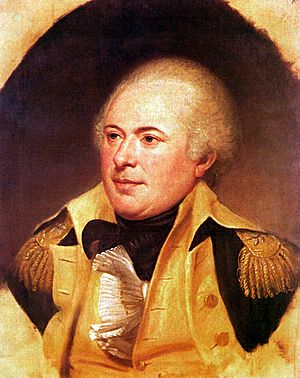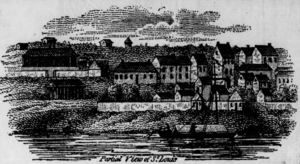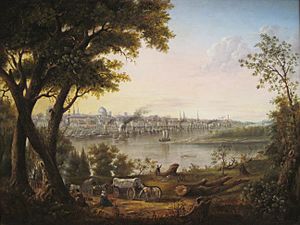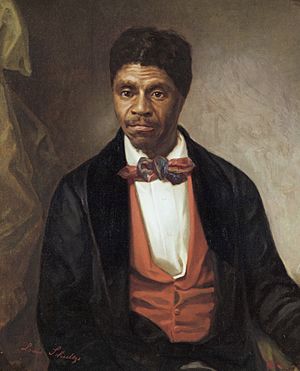History of St. Louis (1804–1865) facts for kids
The history of St. Louis, Missouri from 1804 to 1865 is a story of big changes. St. Louis became the capital of the Louisiana Territory. It grew quickly, faced tough times, then grew even faster with the arrival of steamboats. People also argued about immigration and slavery. St. Louis was important during the American Civil War.
Contents
St. Louis: A Changing Government
After the United States took control of the Louisiana Purchase in 1804, St. Louis became part of the new District of Louisiana. This area was governed by officials from the Indiana Territory. Many wealthy families in St. Louis were unhappy with these new rules. They felt St. Louis was losing its importance.
These families asked the U.S. Congress to change things. In 1805, Congress created the Louisiana Territory, and St. Louis became its capital! James Wilkinson was appointed the first governor. However, he quickly became unpopular. He was replaced by Meriwether Lewis, a famous explorer from the Lewis and Clark Expedition. Sadly, Lewis died a few years later.
Becoming a Town and City
As St. Louis grew, people wanted more control over their local rules. In 1809, St. Louis officially became a town. A group called the Board of Trustees was elected to make decisions. They mostly focused on rules about enslaved people and keeping the streets safe. They also started a volunteer fire department.
In 1812, the Louisiana Territory was renamed the Missouri Territory. St. Louis remained its capital until 1821. The area around St. Louis became St. Louis County. It had the most representatives in the new territorial government.
After the War of 1812, St. Louis grew very fast. Its population more than tripled between 1810 and 1820. Important citizens like Auguste Chouteau donated land for a county courthouse. The famous Old St. Louis County Courthouse was built there in 1828.
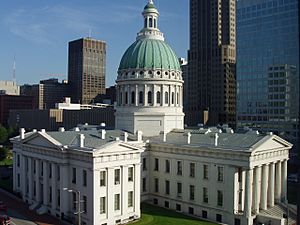
Many people in St. Louis wanted Missouri to become a state. In 1820, the Missouri Compromise allowed Missouri to become a state. St. Louis hosted the meeting where Missouri's first constitution was written. The state capital later moved to St. Charles, and then to Jefferson City. St. Louis didn't seem to mind losing its capital status.
In 1822, St. Louis officially became a city with its own charter. The first mayor of St. Louis was William Carr Lane. He won against Auguste Chouteau. The city limits expanded, and a new group called the Board of Aldermen was elected.
The new city government worked on improving the riverfront and city health. They planned to pave streets and sidewalks. However, progress was slow, and many streets remained dirt roads for years. They also renamed streets, giving numbers to north-south streets and tree names to east-west streets.
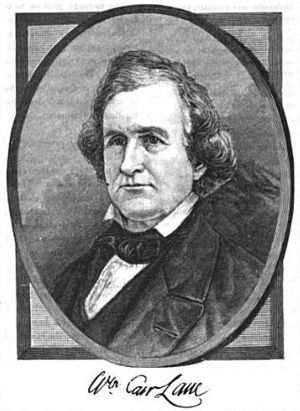
Religion in Early St. Louis
When the U.S. took over Louisiana, the Catholic Church in St. Louis faced money problems. The Spanish government used to pay for everything. So, the local priest left in 1804. Traveling priests visited only a few times a year. Still, many people were baptized in the church.
In 1818, Bishop Louis William Valentine Dubourg arrived in St. Louis. He ordered a new brick church to be built. It was much larger and cost over $24,000. Even though the inside was never finished, the first mass was held there on Christmas Day in 1819. Bishop Dubourg helped the Catholic Church grow in St. Louis. In 1827, St. Louis got its own diocese, with Joseph Rosati as the first bishop.
Protestant Churches Grow
Protestants also started to organize in St. Louis. The Baptists formed a group in 1807 and built a church in 1815. The first Protestant church inside St. Louis was built in 1818 by Baptist missionary John Mason Peck. Methodist ministers also came to town, forming a group in 1821.
The Presbyterian Church was organized in 1817. The Episcopal Church started in 1825. Even with these new churches, many people in St. Louis were not very interested in organized religion.
St. Louis: A Growing Economy
In the early 1800s, St. Louis's economy was all about the fur trade. Families like the Chouteaus and companies like the Missouri Fur Company traded furs with Native Americans. The famous Lewis and Clark Expedition even started from St. Louis in 1804. The fur trade made many wealthy families in St. Louis rich until the 1820s.
As more American families moved to St. Louis, new brick buildings appeared. Businesses like printing and banking also started. Joseph Charless, an Irish immigrant, published the first newspaper west of the Mississippi River in St. Louis in 1808. It was called the Missouri Gazette.
Money Problems and Steamboats
In the 1810s, St. Louis faced money problems. There wasn't enough real money (coins), and too much unreliable paper money. To help, merchants formed the Bank of St. Louis in 1816. But it failed due to bad management. Another bank, the Bank of Missouri, opened and was successful for a while. However, a national money crisis called the Panic of 1819 caused it to close.
This economic downturn slowed down business in St. Louis until the mid-1820s. But then, things picked up again. St. Louis businesses started selling supplies to farmers heading west. They also supplied military bases.
A big reason for this recovery was the steamboat. The first steamboat, the Zebulon M. Pike, arrived in St. Louis on August 2, 1817. Soon, steamboats were common. St. Louis became a busy inland port because rapids north of the city made it the farthest north many large riverboats could go.
Economic Growth Before the Civil War
The new steamboat power led to more types of businesses in St. Louis. Candy shops, jewelers, bookstores, and lumber yards opened in the late 1820s and 1830s. Banking also returned. The city's Merchants Exchange, founded in 1836, was the first place in the U.S. to trade goods like crops. The fur trade continued to be important too.
The fur trade changed from trading with Native Americans to directly trapping and shipping furs. The Rocky Mountain Fur Company was a pioneer in this. Famous mountain men like Jim Bridger and Jedediah Smith were part of this company. Even though this company later closed, St. Louis remained the center for the western fur trade. However, by the 1830s, beaver fur was no longer popular. St. Louis then became a hub for buffalo hides and other furs.
As trade grew, so did the city's buildings. The Old St. Louis County Courthouse encouraged more building. The city expanded its western edge to 14th Street. A military base, Jefferson Barracks, moved south of the city. An armory was built, leading to more industry and a railroad line. The town of Bremen to the north was also added to St. Louis.
St. Louis's population grew dramatically in the 1830s and 1840s. By 1850, it had over 77,000 people. It became the largest U.S. city west of Pittsburgh, Pennsylvania, and the second-largest port in the country, after New York City.
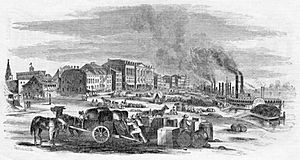
Improving City Infrastructure
The rapid growth of St. Louis led to problems, especially with disease. In 1849, a serious cholera outbreak killed nearly 5,000 people. To solve this, city officials built a sewer system. They also moved cemeteries to the edge of town and drained a large pond.
In the same year, a huge fire started on a steamboat. It spread to 23 other boats and then destroyed a large part of the city center. Many businesses were ruined, and thousands lost their jobs or homes. After the fire, streets were widened, the riverfront was improved, and new building rules required structures to be made of stone or brick.
The levee (riverbank) also saw big improvements in the 1850s. An island called Bloody Island had formed in the Mississippi River, making people worry the St. Louis port would dry up. With federal help and engineering plans by Robert E. Lee, levees were built on the Illinois side. This directed water back towards St. Louis, connecting Bloody Island to the Illinois land.
Before the Civil War, St. Louis also worked on its water system. People originally got water directly from the river. Pumping stations and reservoirs were built, but they quickly became too small for the growing city. Even with expansions, water quality and supply didn't improve much before the war.
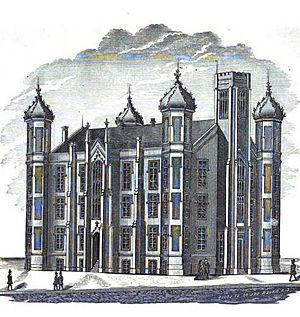
Education Before the Civil War
Joseph Charless, the newspaper printer, also published the first book in the Missouri Territory. Most wealthy people in St. Louis owned private book collections. However, many adults could not read or write.
Early schools in St. Louis charged fees and often taught in French. The Catholic Church made a big effort in education. In 1818, they opened Saint Louis Academy, which later became Saint Louis University. It offered courses in religion, philosophy, languages, and math. It mostly served students studying to become priests. Later, Catholic schools taught over 3,000 students in many parochial schools.
Public Schools Begin
Public education in St. Louis started in 1838. The city government used a tax to support two elementary schools. By 1847, taxes allowed for free public education. The school system grew quickly. By 1854, there were 27 schools serving nearly 4,000 students. In 1855, the first public high school opened. By 1860, almost 12,000 students were in St. Louis Public Schools. The district also opened a school to train teachers in 1857, which is now Harris-Stowe State University.
Slavery and Racism in St. Louis
Missouri became a slave state in 1821. Many slave owners moved to Missouri from other states, bringing enslaved people with them. In St. Louis, many free Black people and enslaved people lived and worked. They were often house servants, skilled workers, or laborers on riverboats and docks.
Even though St. Louis grew, the number of enslaved people compared to the total population went down. It's not clear how enslaved people were treated in St. Louis, but many tried to escape. Enslaved people were often sold through newspaper ads. They were sometimes held in the St. Louis jail before being moved. Many worked on steamboats and some escaped across the river to Illinois, a free state. From there, they used the Underground Railroad to reach Canada.
Gaining Freedom
Some enslaved people earned money to buy their own freedom or the freedom of their families. John Berry Meachum was one example. He bought his freedom, then worked to buy his family and others out of slavery. He later became a Baptist minister and founded a church. Other enslaved people were freed by their owners after a period of service, a process called manumission. From 1828 to 1865, almost 1,000 enslaved people gained their freedom in St. Louis.
Some enslaved people also gained freedom through "freedom suits." These were lawsuits allowed by an 1824 Missouri law. The Scypion family brought one of the earliest freedom suits. After many appeals, including to the Missouri Supreme Court and the U.S. Supreme Court, Marguerite Scypion won her case in 1836. This freed her family and ended Indian slavery in Missouri.
In 1846, Dred Scott and his wife Harriet, who were enslaved, sued for their freedom in St. Louis. They argued they should be free because they had lived with their master in free states. The state court ruled in their favor, but the U.S. Supreme Court later ruled against them in 1857. The Supreme Court said that enslaved people could not be citizens. This decision changed the meaning of the Missouri Compromise. However, the Scotts were freed by their master's family that same year.
Between 1814 and 1860, 301 freedom suits were filed in St. Louis courts. However, enslaved people won freedom in less than half of these cases.
Immigration and Local Tensions
During the economic growth of the 1830s, many Irish and German immigrants came to St. Louis. Writings by Gottfried Duden especially encouraged Germans to move to the Midwest, including St. Louis. By the early 1830s, the German population was large enough to be noticed by Americans and French residents. German immigration continued in the 1840s and 1850s, especially after failed revolutions in Europe in 1848.
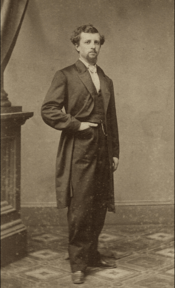
The second large group of immigrants before the Civil War came from Ireland. In the 1830s, some early Irish immigrants in St. Louis were wealthy and powerful. But starting in the mid-1840s, many more Irish people arrived with little money or skills. They were often fleeing poverty from the Great Famine of 1845–1846 and a failed uprising in Ireland in 1848.
Rising Tensions
Feelings against immigrants, called nativist sentiment, grew in St. Louis in the late 1840s. In 1844, a mob attacked Saint Louis University. There were also attacks on new citizens during an election. However, more new citizens meant more votes for Democratic mayors who supported immigrants.
Despite this, nativist feelings led to more riots. In 1849, nativist mobs attacked immigrants and their property. In 1852, German immigrants were accused of attacking nativist Whig Party supporters at a voting place. Germans felt the Whig Party, supported by wealthy families, discriminated against them.
The worst nativist riot in St. Louis happened in 1854. It combined anti-immigrant feelings with the issue of slavery. On election day, August 7, 1854, a nativist mob attacked Irish voters and their property. The fighting spread to the riverfront, where dockworkers joined the fight against the nativists. The mob grew to thousands. The St. Louis police and local army eventually stopped the riot. But 10 people were killed, 33 were wounded, and 93 buildings were damaged. New rules helped prevent such fighting in future elections.
St. Louis During the Civil War
The American Civil War (1861–1865) didn't see much fighting in St. Louis itself. Only a few small battles happened, and Union forces always won. However, the war stopped trade with the Southern states, which hurt St. Louis's economy.
Missouri was a slave state, but its economy didn't rely heavily on slavery. Missouri never left the Union. Some areas of the state saw fighting between different groups. There were also people who fought against slavery, like the Knights of Liberty formed in 1846. The arsenal in St. Louis was used during the war to build ironclad ships for the Union army.


